Using Natural Pozzolans to Partially Replace Cement in Pervious Concretes: A Sustainable Alternative?
Abstract
1. Introduction
2. Materials and Methods
2.1. Materials
2.1.1. Water
2.1.2. Cement
2.1.3. Water–Cement Ratio
2.1.4. Fine Aggregate
2.1.5. Coarse Aggregate
2.1.6. Zeolite
2.1.7. Pumicite
2.1.8. Additive
2.2. Variables to Characterize Pervious Concrete
2.2.1. Compressive Strength
2.2.2. Flexural Strength
2.2.3. Permeability
2.2.4. Porosity
2.2.5. Microanalysis
2.3. Experimental Series
2.4. Experimentation
2.4.1. Pervious Concrete Mix Dosage
2.4.2. Preparation, Compaction, and Curing
3. Results
3.1. Best Reference Sample
3.2. Effects of Pumicite and Zeolite on Pervious Concrete Properties
3.3. SEM Microscopy Analysis
- Calcium silicate hydrate (or C-S-H gel): the main product of the hydration of Portland cement.
- Calcium hydroxide: C-H crystals are large prismatic crystals of calcium hydroxide and C-H surfaces.
- Ettringite: a result of the reaction of calcium aluminate (C3A) with calcium sulfate.
3.4. Effects of Additive on Pervious Concrete Properties
4. Discussion
5. Conclusions
- Considering the incorporation of zeolite as a replacement for cement, it was found that, at any percentage of replacement, the compressive strength and flexural strength decrease. On the other hand, as the percentage of replacement increases, both the permeability and the porosity of the samples increase.
- Considering the incorporation of pumicite as a replacement for cement, the most important findings are those related to compressive and flexural strength. It was observed that with a 10% cement replacement with pumicite, greater compressive and flexural strength were obtained compared to the reference sample, while permeability decreases but not significantly. At 20%, the strengths decrease but are still comparable to the reference sample since they are within the standard deviation range, and the permeability is similar to the reference sample at this percentage.
- The incorporation of a plasticizer additive as a water reducer enables the improvement of the compressive and flexural strength, in all cases, without significantly affecting the permeability or porosity of the samples. However, it is necessary to consider that in the case of pervious concretes, the type of additive to be used and its dosage must be previously investigated in a laboratory to avoid the sedimentation of the cement paste mixture and prevent the generation of an impermeable layer at the bottom of the molds of the samples.
- The difference between the strengths obtained by replacing cement with zeolite or pumicite is explained by interpreting SEM images, which indicate that there are several differences with respect to the reference sample. The samples with zeolite present fewer C-H hexagonal crystals, the C-H surfaces are smaller, there is a greater presence of ettringite, and the C-S-H matrix is less dense than the reference sample. The samples with pumicite, on the other hand, show a dense microporous matrix similar to the reference sample, the C-S-H matrix is denser than the reference sample, and a large number of C-H hexagonal crystals are present.
- The promising results obtained in flexural strength and permeability by replacing the cement with 10% pumicite and incorporating an additive make this technique ideal for use in permeable pavements since a fundamental requirement for its design is flexural strength.
- Finally, being able to replace either 10% or 20% of the cement with locally obtained pozzolanic minerals, from a sustainable point of view, contributes to a reduction in the size of the carbon footprint of the cement industry and promotes the use of supplementary cementitious materials in countries where their use has not yet become widespread.
- The work presented in this article attempted to contribute to a reduction in the use of cement in permeable pavement structures, seeking alternatives to traditional pavements that have less environmental impact, such as natural pozzolans (zeolite and pumicite).
Author Contributions
Funding
Acknowledgments
Conflicts of Interest
References
- Najimi, M.; Sobhani, J.; Ahmadi, B.; Shekarchi, M. An experimental study on durability properties of concrete containing zeolite as a highly reactive natural pozzolan. Constr. Build. Mater. 2012, 35, 1023–1033. [Google Scholar] [CrossRef]
- Divyah, N.; Prakash, R.; Srividhya, S.; Sivakumar, A. Parametric study on lightweight concrete-encased short columns under axial compression-Comparison of design codes. Struct. Eng. Mech. 2022, 83, 387–400. [Google Scholar] [CrossRef]
- Prakash, R.; Divyah, N.; Srividhya, S.; Avudaiappan, S.; Amran, M.; Naidu Raman, S.; Guindos, P.; Vatin, N.I.; Fediuk, R. Effect of Steel Fiber on the Strength and Flexural Characteristics of Coconut Shell Concrete Partially Blended with Fly Ash. Materials 2022, 15, 4272. [Google Scholar] [CrossRef] [PubMed]
- Andrés-Valeri, V.C.; Marchioni, M.; Sañudo-Fontaneda, L.A.; Giustozzi, F.; Becciu, G. Laboratory Assessment of the Infiltration Capacity Reduction in Clogged Porous Mixture Surfaces. Sustainability 2016, 8, 751. [Google Scholar] [CrossRef]
- Yang, J.; Jiang, G. Experimental study on properties of pervious concrete pavement materials. Cem. Concr. Res. 2003, 33, 381–386. [Google Scholar] [CrossRef]
- Takebayashi, H.; Moriyama, M. Study on surface heat budget of various pavements for urban heat island mitigation. Adv. Mater. Sci. Eng. 2012, 2012, 523051. [Google Scholar] [CrossRef]
- Bonicelli, A.; Giustozzi, F.; Crispino, M. Experimental study on the effects of fine sand addition on differentially compacted pervious concrete. Constr. Build. Mater. 2015, 91, 102–110. [Google Scholar] [CrossRef]
- Chandrappa, A.K.; Biligiri, K.P. Pervious concrete as a sustainable pavement material–Research findings and future prospects: A state-of-the-art review. Constr. Build. Mater. 2016, 111, 262–274. [Google Scholar] [CrossRef]
- Nazeer, M.; Kapoor, K.; Singh, S.P. Pervious concrete: A state-of-the-art review. J. Mater. Eng. Struct. 2020, 7, 417–437. [Google Scholar]
- Costa, F.B.P.D.; Lorenzi, A.; Haselbach, L.; Silva Filho, L.C.P.D. Best practices for pervious concrete mix design and laboratory tests. Rev. IBRACON De Estrut. E Mater. 2018, 11, 1151–1159. [Google Scholar] [CrossRef]
- ACI Committe 522. 522R-10: Report on Pervious Concrete; Technical Documents; American Concrete Institute: Farmington Hills, MI, USA, 2010. [Google Scholar]
- Nguyen, D.H.; Sebaibi, N.; Boutouil, M.; Leleyter, L.; Baraud, F. A modified method for the design of pervious concrete mix. Constr. Build. Mater. 2014, 73, 271–282. [Google Scholar] [CrossRef]
- Fernández, L.; Vitola, L.; Salminci, P. Estado del arte en el uso de Hormigones Porosos, XII congreso de Vialidad y Tránsito; Instituto del Cemento Portland Argentino: Buenos Aires, Argentina, 1998; pp. 761–784. [Google Scholar]
- NRMCA. Pervious Concrete: Guideline to Mixture Proportioning and Research Report; National Ready Mixed Concrete Association: Silver Spring, MD, USA, 2009. [Google Scholar]
- Sahdeo, S.K.; Ransinchung, G.D.; Rahul, K.L.; Debbarma, S. Effect of mix proportion on the structural and functional properties of pervious concrete paving mixtures. Constr. Build. Mater. 2020, 255, 119260. [Google Scholar] [CrossRef]
- Huang, J.; Luo, Z.; Khan, M.B.E. Impact of aggregate type and size and mineral admixtures on the properties of pervious concrete: An experimental investigation. Constr. Build. Mater. 2020, 265, 120759. [Google Scholar] [CrossRef]
- FICEM; ICH. Hoja de Ruta de la Industria del Cemento en Chile: Hacia una Economía Baja en Carbono; Federación Interamericana del Cemento; Instituto del Cemento y del Hormigón de Chile: Santiago, Chile, 2019. [Google Scholar]
- Federación Interamericana del Cemento. El Cemento, el Concreto y su Contribución en el Desarrollo de Ciudades Sostenibles y Resilientes, 7th ed.; Cemento & Concreto de Iberoamérica y El Caribe: Bogotá, Colombia, 2020. [Google Scholar]
- Monteiro, P.J.; Miller, S.A.; Horvath, A. Towards sustainable concrete. Nat. Mater. 2017, 16, 698–699. [Google Scholar] [CrossRef]
- Raggiot, B.B.; Positieri, M.J.; Locati, F.; Murra, J.; Marfil, S. Zeolite, study of aptitude as a natural pozzolan applied to structural concrete. Rev. Constr. J. Constr. 2015, 14, 14–20. [Google Scholar] [CrossRef]
- Raggiotti, B.B.; Positieri, M.J.; Oshiro, Á. Natural zeolite, a pozzolan for structural concrete. Procedia Struct. Integr. 2018, 11, 36–43. [Google Scholar] [CrossRef]
- Ahmadi, B.; Shekarchi, M. Use of natural zeolite as a supplementary cementitious material. Cem. Concr. Compos. 2010, 32, 134–141. [Google Scholar] [CrossRef]
- Tran, Y.T.; Lee, J.; Kumar, P.; Kim, K.H.; Lee, S.S. Natural zeolite and its application in concrete composite production. Compos. Part B Eng. 2019, 165, 354–364. [Google Scholar] [CrossRef]
- Emam, E.; Yehia, S. Performance of concrete containing zeolite as a supplementary cementitious material. Int. Res. J. Eng. Technol. 2017, 4, 1619–1625. [Google Scholar]
- Kabay, N.; Tufekci, M.M.; Kizilkanat, A.B.; Oktay, D. Properties of concrete with pumice powder and fly ash as cement replacement materials. Constr. Build. Mater. 2015, 85, 1–8. [Google Scholar] [CrossRef]
- Hossain, K.M.A. Properties of volcanic pumice based cement and lightweight concrete. Cem. Concr. Res. 2004, 34, 283–291. [Google Scholar] [CrossRef]
- Pachideh, G.; Gholhaki, M.; Moshtagh, A. Experimental study on mechanical strength of porous concrete pavement containing pozzolans. Adv. Civ. Eng. Mater. 2020, 9, 38–52. [Google Scholar] [CrossRef]
- Pachideh, G.; Gholhaki, M.; Moshtagh, A. Performance of porous pavement containing different types of pozzolans. Int. J. Eng. 2019, 32, 1277–1283. [Google Scholar] [CrossRef]
- Joshaghani, A. The Effects of Zeolite as Supplementary Cement Material on Pervious Concrete. In Proceedings of the 2016 International Concrete Sustainability Conference, Washington, DC, USA, 15–18 May 2016. [Google Scholar]
- Azad, A.; Saeedian, A.; Mousavi, S.F.; Karami, H.; Farzin, S.; Singh, V.P. Effect of zeolite and pumice powders on the environmental and physical characteristics of green concrete filters. Constr. Build. Mater. 2020, 240, 117931. [Google Scholar] [CrossRef]
- Juenger, M.C.; Snellings, R.; Bernal, S.A. Supplementary cementitious materials: New sources, characterization, and performance insights. Cem. Concr. Res. 2019, 122, 257–273. [Google Scholar] [CrossRef]
- Suraneni, P.; Hajibabaee, A.; Ramanathan, S.; Wang, Y.; Weiss, J. New insights from reactivity testing of supplementary cementitious materials. Cem. Concr. Compos. 2019, 103, 331–338. [Google Scholar] [CrossRef]
- Carsana, M.; Frassoni, M.; Bertolini, L. Comparison of ground waste glass with other supplementary cementitious materials. Cem. Concr. Compos. 2014, 45, 39–45. [Google Scholar] [CrossRef]
- Jiang, P.; Chen, Y.; Wang, W.; Yang, J.; Wang, H.; Li, N.; Wang, W. Flexural behavior evaluation and energy dissipation mechanisms of modified iron tailings powder incorporating cement and fibers subjected to freeze-thaw cycles. J. Clean. Prod. 2022, 351, 131527. [Google Scholar] [CrossRef]
- Mishra, S.; Tamrakar, R. Experimental Studies on Properties of Concrete due to different ingredient based Super Plasticizers. Int. J. Sci. Eng. Technol. Res. 2013, 2, 1036–1040. [Google Scholar]
- Khan, M.; Ali, M. Effect of super plasticizer on the properties of medium strength concrete prepared with coconut fiber. Constr. Build. Mater. 2018, 182, 703–715. [Google Scholar] [CrossRef]
- Malagavelli, V.; Paturu, N.R. Strength and Workability Characteristics of Concrete by using Different super plasticizers. Int. J. Mater. Eng. 2012, 2, 7–11. [Google Scholar] [CrossRef]
- Elkady, H.; Serag, M.I.; Elfeky, M.S. Effect of nano silica de-agglomeration, and methods of adding super-plasticizer on the compressive strength, and workability of nano silica concrete. Civ. Environ. Res. 2013, 3, 21–34. [Google Scholar]
- Topçu, İ.B.; Ateşin, Ö. Effect of high dosage lignosulphonate and naphthalene sulphonate based plasticizer usage on micro concrete properties. Constr. Build. Mater. 2016, 120, 189–197. [Google Scholar] [CrossRef]
- Nagrockiene, D.; Pundienė, I.; Kicaite, A. The effect of cement type and plasticizer addition on concrete properties. Constr. Build. Mater. 2013, 45, 324–331. [Google Scholar] [CrossRef]
- Elizondo-Martínez, E.-J.; Andrés-Valeri, V.-C.; Rodríguez-Hernández, J.; Sangiorgi, C. Selection of Additives and Fibers for Improving the Mechanical and Safety Properties of Porous Concrete Pavements through Multi-Criteria Decision-Making Analysis. Sustainability 2020, 12, 2392. [Google Scholar] [CrossRef]
- INN. Hormigón y Mortero—Agua de Amasado—Clasificación y Requisitos; NCh1498.2012; Instituto Nacional de Normalización: Santiago, Chile, 2012. [Google Scholar]
- INN. Cemento—Terminología, Clasificación y Especificaciones Generales; NCh148.1968; Instituto Nacional de Normalización: Santiago, Chile, 1968. [Google Scholar]
- Kováč, M.; Sičáková, A. Pervious Concrete as an Environmental Solution for Pavements: Focus on Key Properties. Environments 2018, 5, 11. [Google Scholar] [CrossRef]
- Deo, O.; Neithalath, N. Compressive response of pervious concretes proportioned for desired porosities. Constr. Build. Mater. 2011, 25, 4181–4189. [Google Scholar] [CrossRef]
- INN. Áridos para Morteros y Hormigones—Requisitos Generales; NCh163.1979; Instituto Nacional de Normalización: Santiago, Chile, 1979. [Google Scholar]
- INN. Áridos para Morteros y Hormigones—Determinación de las Densidades reales y neta y de la Absorción de agua de las Arenas; NCh1239.2009; Instituto Nacional de Normalización: Santiago, Chile, 2009. [Google Scholar]
- INN. Áridos para Morteros y Hormigones—Tamizado y Determinación de la Granulometría; NCh165.2009; Instituto Nacional de Normalización: Santiago, Chile, 2009. [Google Scholar]
- INN. Áridos para Morteros y Hormigones—Determinación de las Densidades Reales y neta y de la Absorción de agua de las Gravas; NCh1117.2010; Instituto Nacional de Normalización: Santiago, Chile, 2010. [Google Scholar]
- ASTM C618-19; Standard Specification for Coal Fly Ash and Raw or Calcinated Natural Pozzolan for Use in Concrete. ASTM International: West Conshohocken, PA, USA, 2019.
- INN. Hormigón y Mortero—Aditivos—Clasificación y Requisitos; NCh2182.1995; Instituto Nacional de Normalización: Santiago, Chile, 1995. [Google Scholar]
- INN. Hormigón—Ensayo de Compresión de Probetas Cúbicas y Cilíndricas; NCh1037.2009; Instituto Nacional de Normalización: Santiago, Chile, 2009. [Google Scholar]
- INN. Hormigón—Ensayo de Tracción por Flexión; NCh1038.2009; Instituto Nacional de Normalización: Santiago, Chile, 2009. [Google Scholar]
- ASTM C1754/C1754M-12; Standard Test Method for Density and Void Content of Hardened Pervious Concrete. ASTM International: West Conshohocken, PA, USA, 2012.
- Cires, F.A. Propuesta de Método de Diseño de Mezclas de Hormigón Poroso para Pavimentos Permeables. Bachelor’s Thesis, University of Concepción, Concepción, Chile, 2021. [Google Scholar]
- INN. Hormigón—Confección en obra y Curado de Probetas para Ensayos de Compresión, Tracción por Flexión y por Hendimiento; NCh1017.2009; Instituto Nacional de Normalización: Santiago, Chile, 2009. [Google Scholar]
- Ramezanianpour, A.A.; Mousavi, R.; Kalhori, M.; Sobhani, J.; Najimi, M. Micro and macro level properties of natural zeolite contained concretes. Constr. Build. Mater. 2015, 101, 347–358. [Google Scholar] [CrossRef]
- Collepardi, M. A state-of-the-art review on delayed ettringite attack on concrete. Cem. Concr. Compos. 2003, 25, 401–407. [Google Scholar] [CrossRef]
- Kunther, W.; Ferreiro, S.; Skibsted, J. Influence of the Ca/Si ratio on the compressive strength of cementitious calcium–silicate–hydrate binders. J. Mater. Chem. A 2017, 5, 17401–17412. [Google Scholar] [CrossRef]
- U.S. Geological Survey. Mineral Commodity Summaries 2021; U.S. Geological Survey: Reston, VA, USA, 2021. [CrossRef]
- Tennis, P.D.; Leming, M.L.; Akers, D.J. Pervious Concrete Pavements; Portland Cement Association: Skokie, IL, USA; National Ready Mixed Concrete Association: Silver Spring, MD, USA, 2004. [Google Scholar]
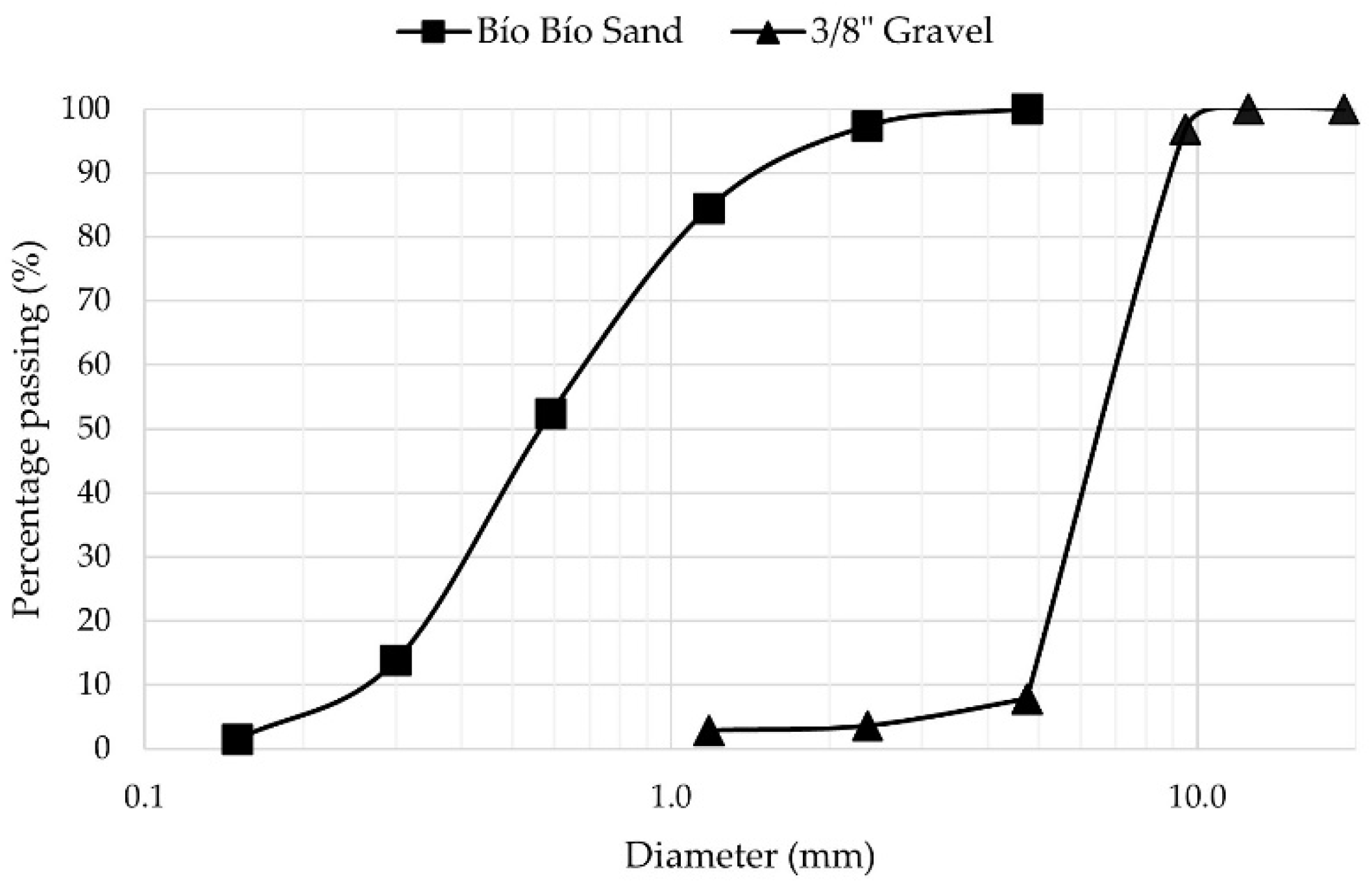
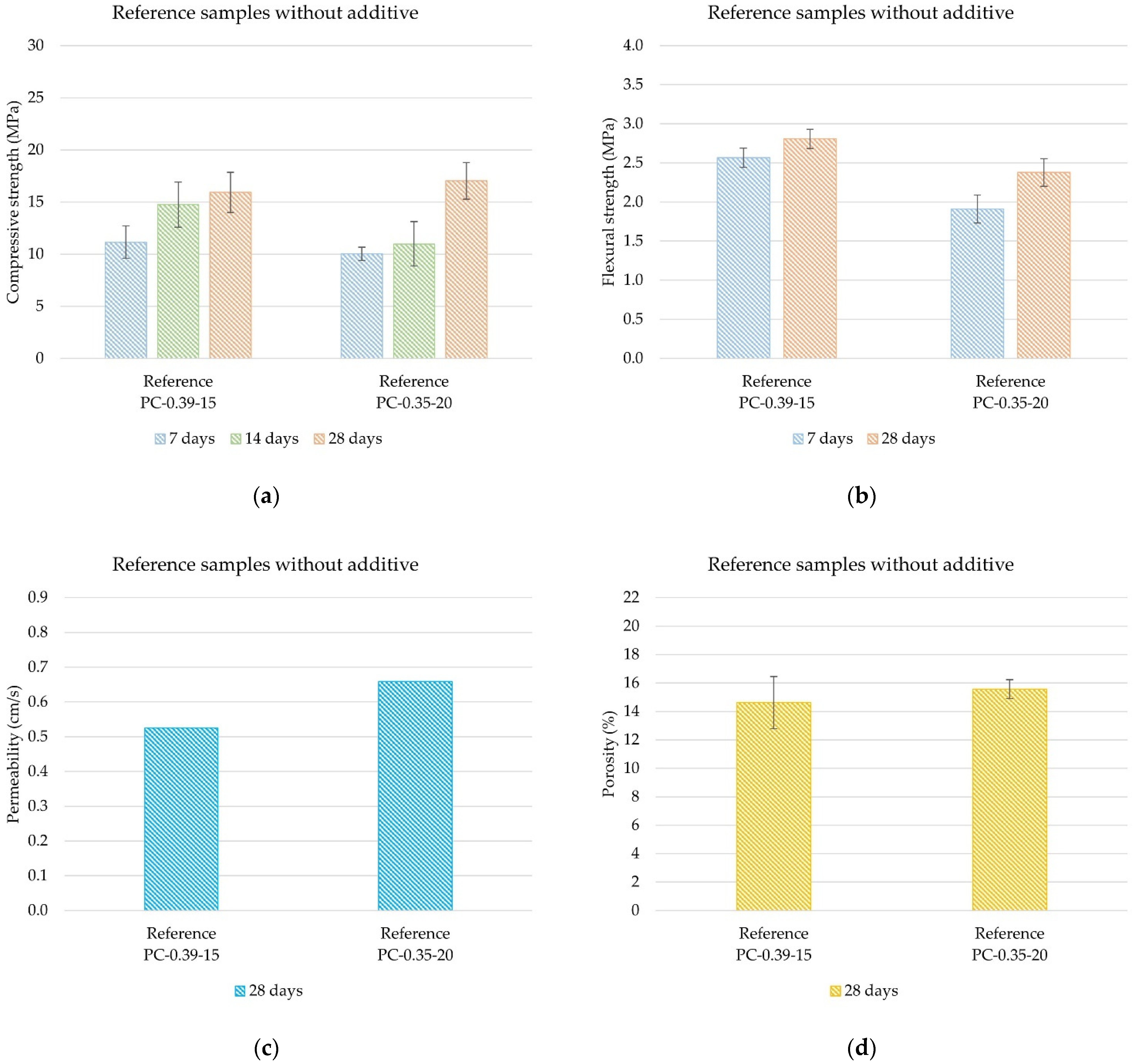
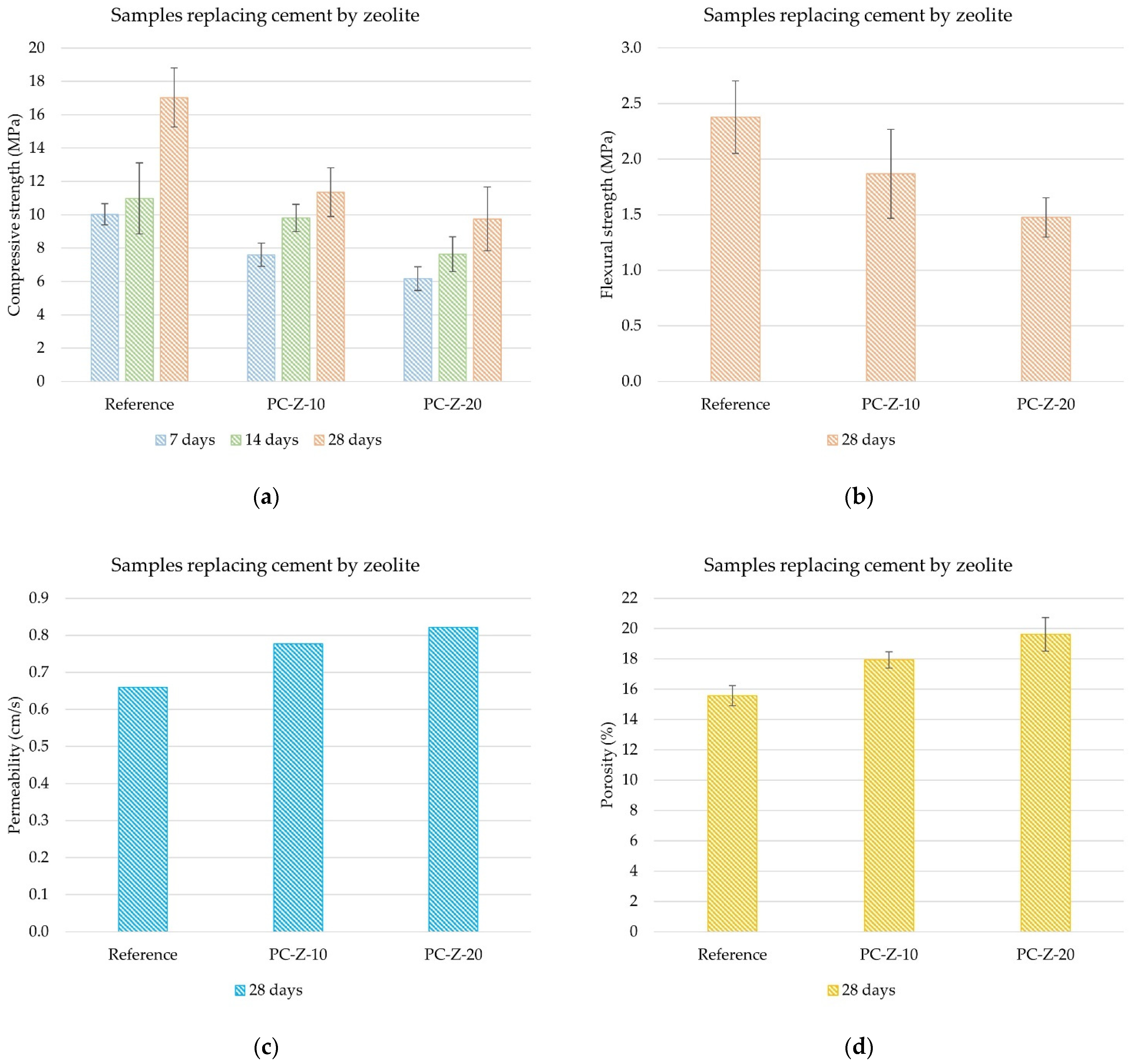

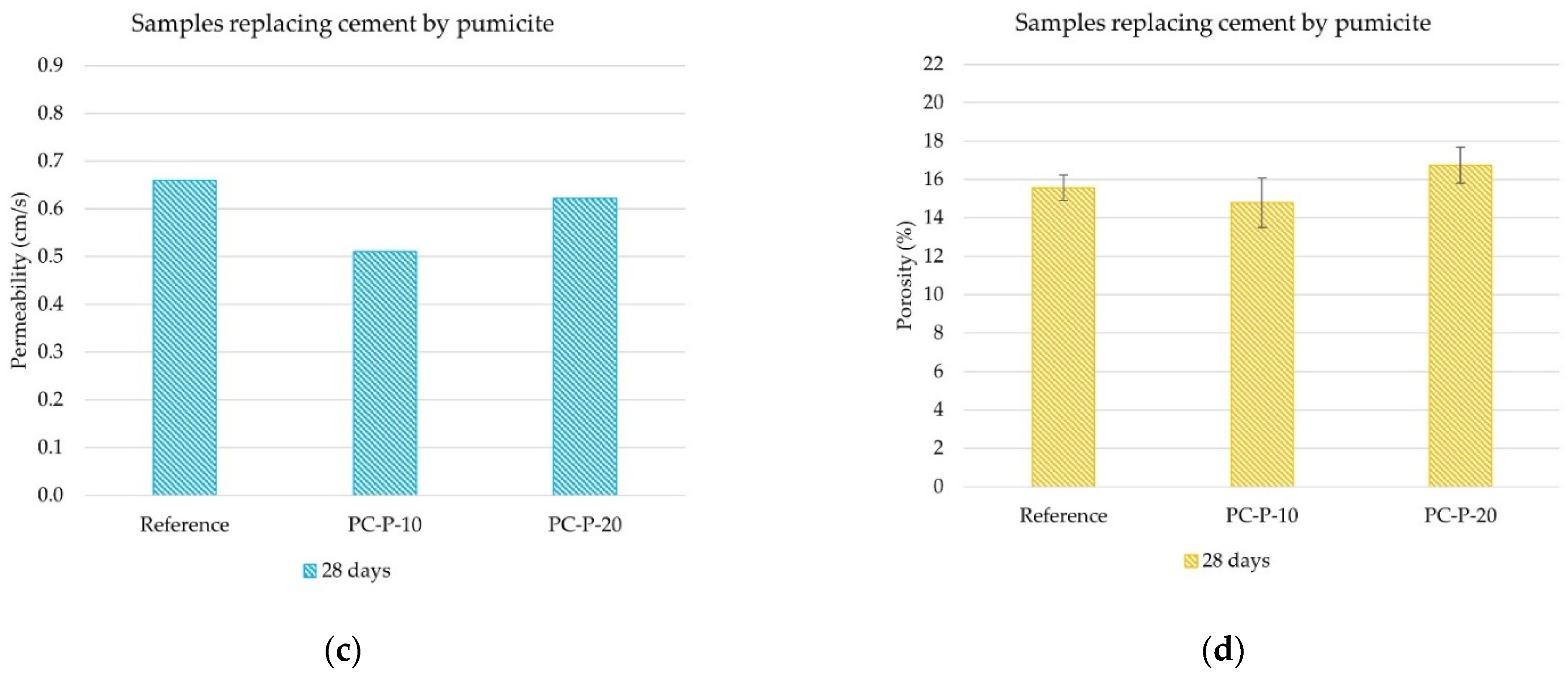
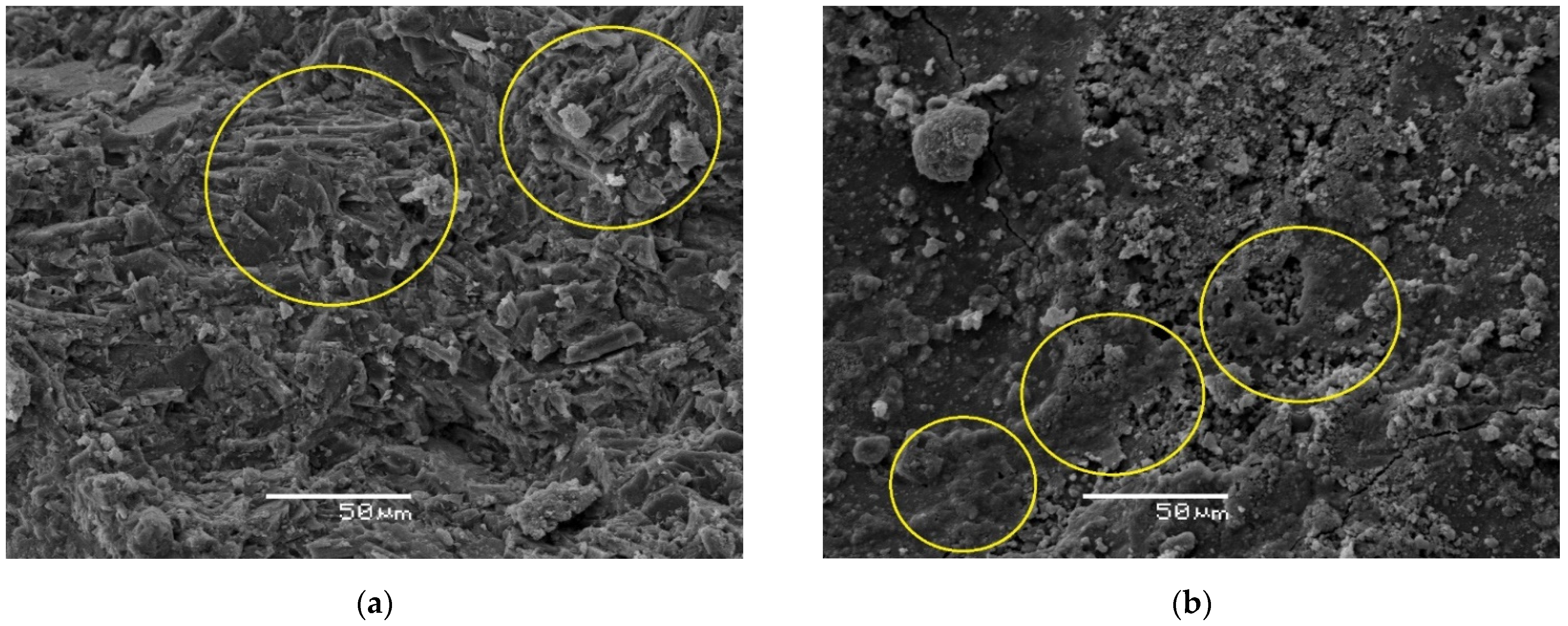
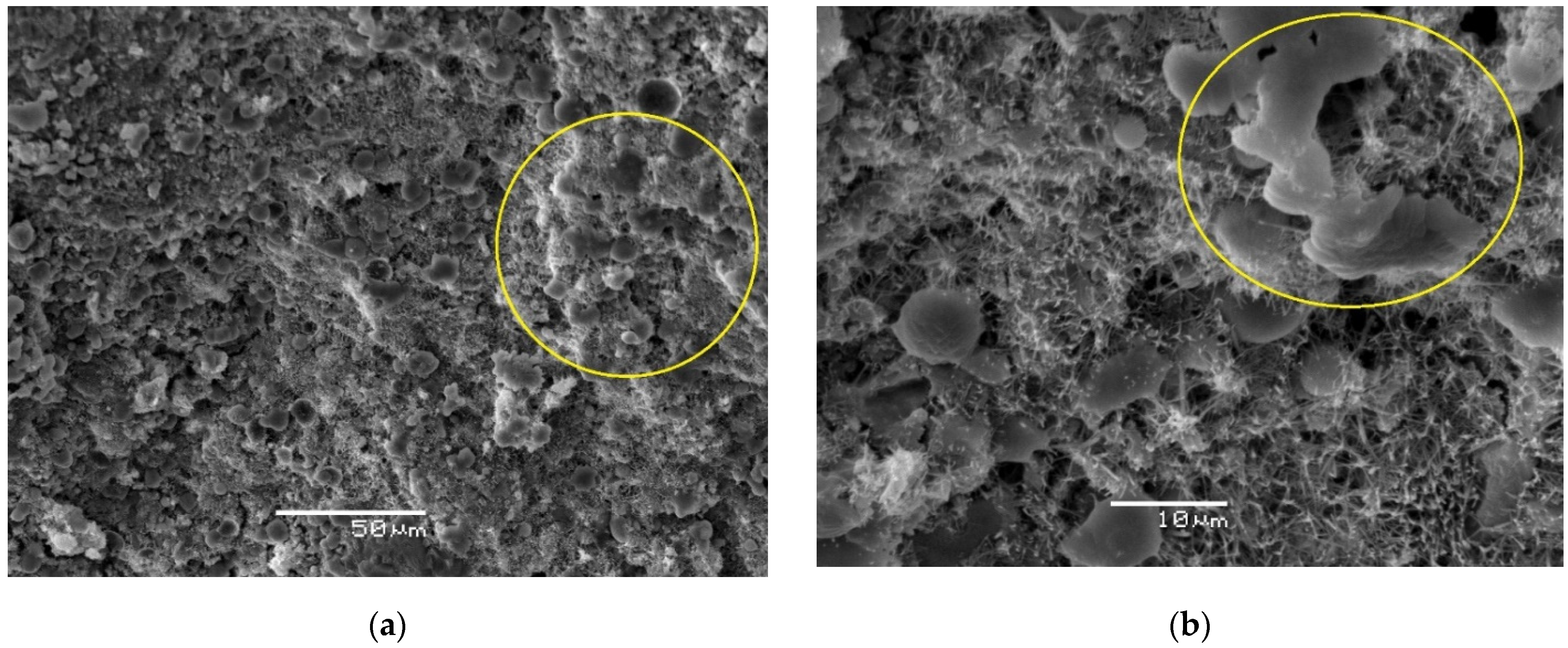

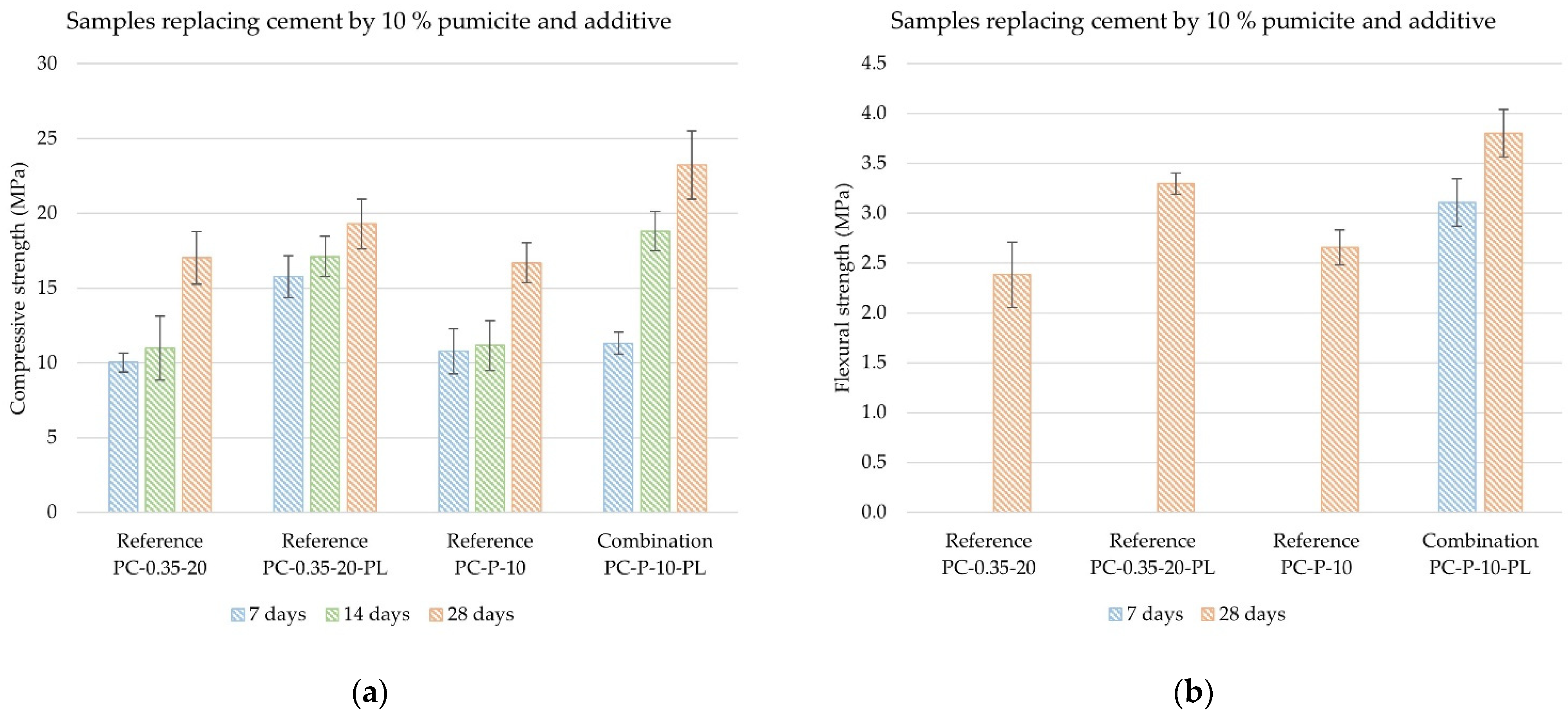
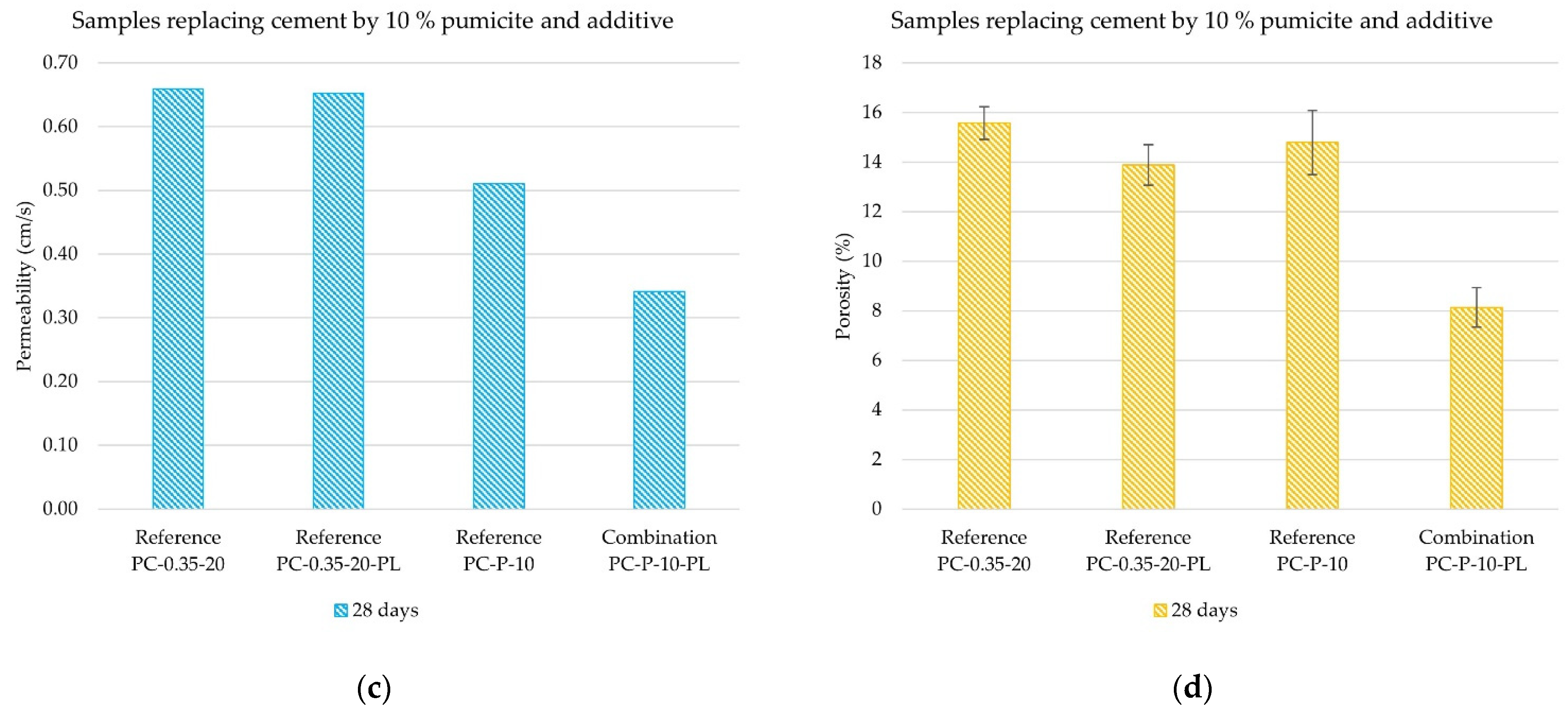
| Properties | Cement | Requirements NCh 148 | |
|---|---|---|---|
| Specific gravity (g/cm3) | 2.8 | - | |
| Autoclave expansion (%) | 0.1 | <1.0 | |
| Initial setting (h:m) | 02:40 | >1.00 | |
| Final setting (h:m) | 03:40 | <12:00 | |
| Compressive strength (kg/cm2) | 7 days | 320 | >180 |
| 28 days | 410 | >250 |
| Physical Properties | Fine Aggregate | Coarse Aggregate |
|---|---|---|
| Relative Density (kg/m3) | 2682 | 2643 |
| Relative Density SSD (kg/m3) | 2729 | 2683 |
| Apparent Relative Density (kg/m3) | 2814 | 2752 |
| Compacted Bulk Density (kg/m3) | 1635 | 1500 |
| Water Absorption (%) | 1.75 | 1.49 |
| Materials finer than #200 sieve (%) | 0.59 | 0.05 |
| Fineness Modulus | 2.53 | 8.89 |
| Series | Experiment | W/C | FA/CA | Z | P | A 1 | P1 | P2 | P3 | P4 |
|---|---|---|---|---|---|---|---|---|---|---|
| 1 | 1 | 0.39 | 15% | 0 | 0 | 0 | 7-14-28 | 7-28 | 28 | 28 |
| 2 | 0.35 | 20% | 0 | 0 | 0 | 7-14-28 | 7-28 | 28 | 28 | |
| 2 | 1 | 0.35 | 20% | 10% | 0 | 0 | 7-14-28 | 28 | 28 | 28 |
| 2 | 0.35 | 20% | 20% | 0 | 0 | 7-14-28 | 28 | 28 | 28 | |
| 3 | 0.35 | 20% | 0 | 10% | 0 | 7-14-28 | 28 | 28 | 28 | |
| 4 | 0.35 | 20% | 0 | 20% | 0 | 7-14-28 | 28 | 28 | 28 | |
| 3 | 1 | 0.35 | 20% | 0 | 0 | 0.7% | 7-14-28 | 7-28 | 28 | 28 |
| 2 | 0.35 | 20% | 0 | 10% | 0.7% | 7-14-28 | 7-28 | 28 | 28 |
| Series | Exp. | Mixture ID | Gravel | Sand | Cement | Water | Zeolite | Pumicite | Additive 1 |
|---|---|---|---|---|---|---|---|---|---|
| 1 | 1 | PC-0.39-15 | 1345.7 | 201.9 | 345.3 | 134.7 | - | - | - |
| 2 | PC-0.35-20 | 1325.5 | 265.2 | 341.8 | 119.6 | - | - | - | |
| 2 | 1 | PC-Z-10 | 1325.5 | 265.2 | 310.7 | 119.6 | 31.1 | - | - |
| 2 | PC-Z-20 | 1325.5 | 265.2 | 284.8 | 119.6 | 57.0 | - | - | |
| 3 | PC-P-10 | 1325.5 | 265.2 | 310.7 | 119.6 | - | 31.1 | - | |
| 4 | PC-P-20 | 1325.5 | 265.2 | 284.8 | 119.6 | - | 57.0 | - | |
| 3 | 1 | PC-0.35-20-PL | 1325.5 | 265.2 | 341.8 | 101.7 | - | - | 0.7 |
| 2 | PC-P-10-PL | 1325.5 | 265.2 | 310.7 | 101.7 | - | 31.1 | 0.7 |
Publisher’s Note: MDPI stays neutral with regard to jurisdictional claims in published maps and institutional affiliations. |
© 2022 by the authors. Licensee MDPI, Basel, Switzerland. This article is an open access article distributed under the terms and conditions of the Creative Commons Attribution (CC BY) license (https://creativecommons.org/licenses/by/4.0/).
Share and Cite
Oviedo, I.; Pradena, M.; Link, Ó.; Balbo, J.T. Using Natural Pozzolans to Partially Replace Cement in Pervious Concretes: A Sustainable Alternative? Sustainability 2022, 14, 14122. https://doi.org/10.3390/su142114122
Oviedo I, Pradena M, Link Ó, Balbo JT. Using Natural Pozzolans to Partially Replace Cement in Pervious Concretes: A Sustainable Alternative? Sustainability. 2022; 14(21):14122. https://doi.org/10.3390/su142114122
Chicago/Turabian StyleOviedo, Ignacio, Mauricio Pradena, Óscar Link, and José T. Balbo. 2022. "Using Natural Pozzolans to Partially Replace Cement in Pervious Concretes: A Sustainable Alternative?" Sustainability 14, no. 21: 14122. https://doi.org/10.3390/su142114122
APA StyleOviedo, I., Pradena, M., Link, Ó., & Balbo, J. T. (2022). Using Natural Pozzolans to Partially Replace Cement in Pervious Concretes: A Sustainable Alternative? Sustainability, 14(21), 14122. https://doi.org/10.3390/su142114122








